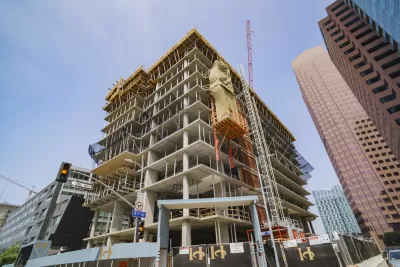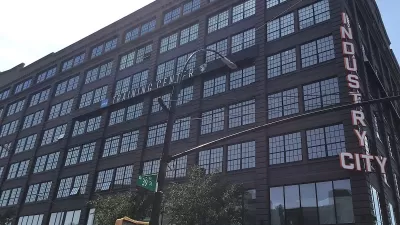Even if new housing reduces rents regionwide, scholars are divided as to when and whether new market-rate apartments reduce rents in nearby blocks. A new study seeks to answer this question.

Numerous economic studies show that cities that allow lots of new housing have lower housing costs than places with highly restrictive zoning, and thus that the anti-housing policies of cities such as New York and San Francisco (and their suburbs) contribute to regional high rents.
But even pro-housing commentators have suggested that this might not be true at the neighborhood-by-neighborhood level, at least in newly gentrifying neighborhoods. Some believe that such housing increases demand for a neighborhood, which in turn breeds gentrification, which in turn creates higher rents.
However, a new study, performed by two economists and one doctoral student,* suggests that new market-rate housing reduces rents. This study covered buildings in 11 major cities that were built between 2014 and 2016. As a proxy for gentrification, the study focused on areas where there was "no other luxury building within 500 meters." However, these areas were already wealthier than the citywide average, with rising rents and an above-average percentage of new housing built since 2010.
The study found that before construction, rents rose more rapidly within 200 meters of these new buildings than in areas 200-800 meters away. By contrast, after construction rents rose more slowly within 200 meters of these buildings. Thus, it appears that these new buildings caused rents to rise less rapidly (at a time when rents were increasing almost everywhere). Although neighborhood population increased near these buildings, the increased demand was not sufficient to raise rents.
On the other hand, this study does not necessarily prove that new housing in every conceivable neighborhood will lower housing prices. At least two questions require further research: First, do these results apply for all cities? Or is there a difference between already-expensive cities such as New York (where upzoned areas are often just a few blocks away from downzoned areas, thus funneling demand into the former set of areas) and cheaper cities such as Atlanta? Second, are the results different for lower-income neighborhoods (as opposed to neighborhoods that are middle-class or nonresidential)?
*I am happy to mention them and thus plug their work: Brian James Asquith, Evan Mast, and Davin Reed.

Study: Maui’s Plan to Convert Vacation Rentals to Long-Term Housing Could Cause Nearly $1 Billion Economic Loss
The plan would reduce visitor accommodation by 25,% resulting in 1,900 jobs lost.

North Texas Transit Leaders Tout Benefits of TOD for Growing Region
At a summit focused on transit-oriented development, policymakers discussed how North Texas’ expanded light rail system can serve as a tool for economic growth.

Why Should We Subsidize Public Transportation?
Many public transit agencies face financial stress due to rising costs, declining fare revenue, and declining subsidies. Transit advocates must provide a strong business case for increasing public transit funding.

How to Make US Trains Faster
Changes to boarding platforms and a switch to electric trains could improve U.S. passenger rail service without the added cost of high-speed rail.

Columbia’s Revitalized ‘Loop’ Is a Hub for Local Entrepreneurs
A focus on small businesses is helping a commercial corridor in Columbia, Missouri thrive.

Invasive Insect Threatens Minnesota’s Ash Forests
The Emerald Ash Borer is a rapidly spreading invasive pest threatening Minnesota’s ash trees, and homeowners are encouraged to plant diverse replacement species, avoid moving ash firewood, and monitor for signs of infestation.
Urban Design for Planners 1: Software Tools
This six-course series explores essential urban design concepts using open source software and equips planners with the tools they need to participate fully in the urban design process.
Planning for Universal Design
Learn the tools for implementing Universal Design in planning regulations.
Ascent Environmental
Borough of Carlisle
Institute for Housing and Urban Development Studies (IHS)
City of Grandview
Harvard GSD Executive Education
Toledo-Lucas County Plan Commissions
Salt Lake City
NYU Wagner Graduate School of Public Service






























